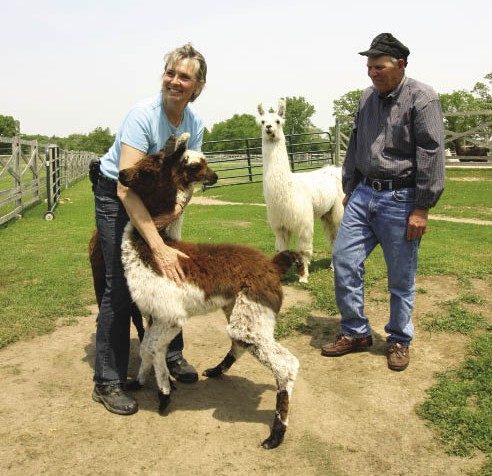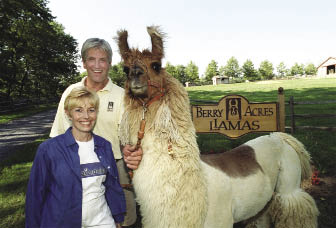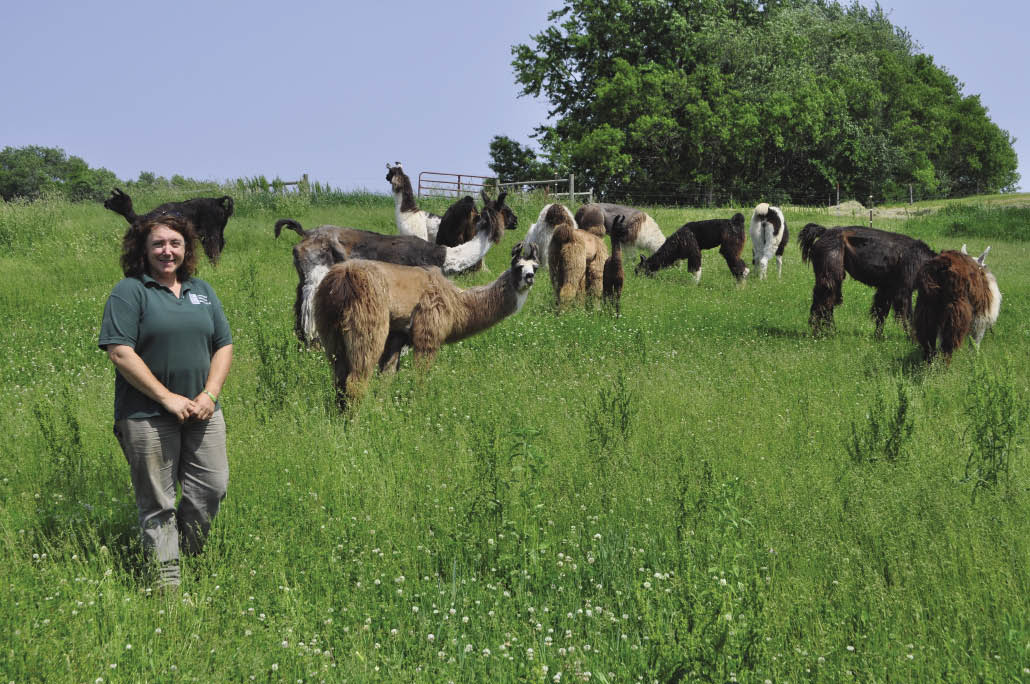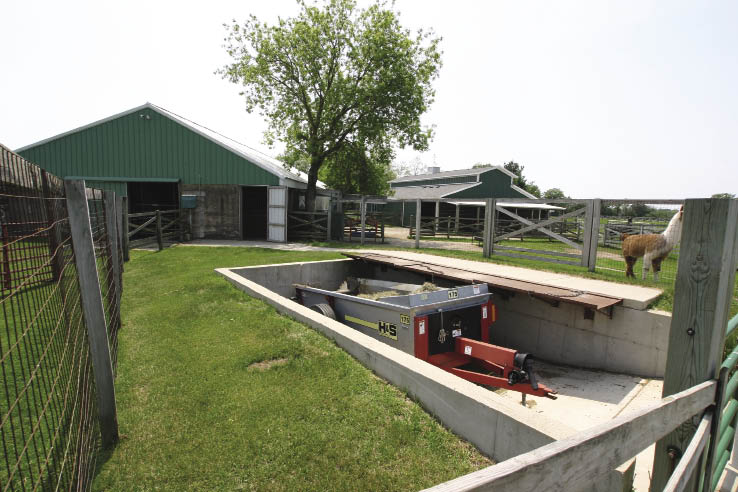There are two questions that every llama enthusiast has come to expect when talking to people with little knowledge of the animals: “Do they spit?” and “What do you do with a llama?”
Dan Goodyear smiles and says, “Yes. Those are usually the first two question people ask.”
His wife Dale adds, “It’s like asking, ‘Do dogs bite?’ But that one is easy enough to answer.”
With 250 animals at their Berry Acres Llamas farm in Robesonia, Pa., up until recently, Dan and Dale Goodyear were among the largest llama breeders in the U.S. For nearly 20 years, while Dan ran his company, Pennsylvania Steel & Machine in Hamburg, Pa., he and Dale bred some of the finest animals in the country. They’re retired now and age and other issues no longer allow them to pursue the hobby-turned-business pastime they both loved. Their farm is for sale as they look to downsize. But they still love talking about llamas, and they still have dozens of friends who remain active breeders — and who also love talking llamas.
The answer to the first question is “Yes, llamas spit,” Dan says, “but they seldom spit at people unless they’re provoked. Most of that reputation comes from people poking at poorly trained llamas and alpacas through the fence at the zoo.”
Llama aficionados explain that spitting is most often the llama’s way of disciplining other llamas in the herd that are acting out or are just plain annoying.
Dr. Kristy Brown, a veterinarian who maintains 50 llamas on The Brownderosa farm near Sparta, Wis., adds, “Spitting is a defense. They’ll spit at each other over space and mothers do it to protect their babies. But even as a veterinarian who specializes in treating camelids (llamas and alpacas), it’s very seldom that I get spit at.”
Why Llamas?
As for the second question, “What do you do with a llama?” This is where the enthusiasts would prefer to start the conversation.
Dale Goodyear waxes eloquent when she describes why she and Dan enjoyed breeding the animals for nearly 20 years. “At the center of all this is the fact that we just fell in love with llamas, with their temperament and their serenity. They’re very quiet, beautiful animals that enhanced our lives. So building a business based on this was key because with anything that you’re ultimately going to sell, it helps if you see the inherent value in ownership. It’s different, however, with animals because you’ve been fortunate to be stewards of those animals. To pass them on in a way that brings joy to other people is very gratifying.”
Other owners are raising and breeding llamas for other reasons, from the ability to rapidly depreciate llamas and alpacas, to offset income to the fine fiber they produce. Through their own efforts at breeding premium animals, the Goodyears were able to improve the fleece of their llamas — even rivaling that of alpacas — making it a valuable commodity for everything from rugs to sweaters.
Others raise the animals to show and sell. The Alpaca and Llama Show Assn. sanctions more than 140 shows in North America.
With minimal training, llamas have proven to be effective guard animals. Nearly every owner has stories about the protective instincts of these animals.
Barbara and Tom Parsons have watched their llamas in action at their 40-acre Animal Acres Llamas farm near Dousman, Wis. “You wouldn’t think to look at these mellow, laid-back critters, how engrained these instincts are,” says Barbara. “When they’re put in charge of sheep, goats or alpacas, they literally do not like strange creatures coming into their pastures.”
The Parsons tell the story of how a neighbor’s dog would come into one of their pastures and dig up gopher holes. “One day we watched a big female take off after that dog, bumped it with her head and sent it rolling underneath the fence. We’ve never had a problem with that dog again.”
Dr. Brown also talks about the strikingly different personalities that llamas possess. “If a stray dog or coyote enters its territory, these large beasts will confront them confidently. Sometimes the bluff does as much protecting as anything. When we had sheep, I’ve watched our guard llama kill a coyote. He ran after it, chased it down, hit it with his head, and stomped on it until it was dead. Yet, you could give that animal to a little kid and they’d walk him all over the place.
“That’s what impressed me and made me sell my 50 sheep and 20 beef cows and end up with 50 llamas,” Dr. Brown says. “It was their versatility, protective nature and gentleness all built into the same critter.”
With their sure-footedness, llamas are also used as pack animals and to pull carts. With their curious and intuitive nature, they’re also used as therapy pets. According to Dale Goodyear, llamas are well suited to work with special needs children, handicapped and elderly people. “Some of our llamas have gone into the hands of people who regularly take them into schools and senior citizens’ homes. Some have done wonderful work with autistic children. A few of our llamas have achieved full certification as therapy animals.”
A Sizable ‘Niche’ Market
|
Until recently, Dan and Dale Goodyear were among the largest llama breeders in the U.S. for nearly 20 years. “At the center of all this is the fact that we just fell in love with llamas, with their temperament and their serenity. They’re very quiet, beautiful animals that enhanced our lives,” says Dale. |
It’s estimated that there are 200,000 llamas and alpacas in North America today. This includes those animals that aren’t officially registered by the International Lama Registry. The ILR reports that more than 166,000 llamas and alpacas are registered to nearly 30,000 owners throughout the U.S. and Canada.
The top states for these critters include Oregon, California, Texas, Washington and Ohio where nearly one-third of llamas in North America reside. But the ILR lists llama owners in 49 of the 50 states.
In Canada, the only significant llama herds can be found in Alberta and British Columbia. (See “Where the Llamas and Alpacas Are in North America” on p. 28.)
For equipment dealers, this represents a nice size niche market as llama breeders typically utilize much of the same equipment and require the same — or more — services as other livestock producers and rural lifestylers.
Experience with Equipment
|
“When working with beginners, dealers should put more emphasis on the smaller ground-drive, four-wheeler type equipment and lawn tractor type of attachments. They need equipment that meets their abilities. So, smaller utility wagons, ground-drive manure spreaders are most appropriate for them,” Dr. Kristy Brown says. |
The llama owners that Rural Lifestyle Dealer spoke with demonstrated a range of farming, equipment and dealer experience.
Dan and Dale Goodyear owned and operated a gamut of farming equipment to maintain and grow their llama farm. He lists a New Holland skid steer with a variety of attachments, including a bucket, posthole digger and plows. “That was a great all-around vehicle,” he says.
They also owned two Kubota tractors, mowers, two Kawasaki Mule utility vehicles, a Club Car UTV, an Exmark mower, sprayers and a variety of hand tools, including chain saws and grass trimmers.
The Club Car 1200 had a dump bed, but was set up to attach extra seats. “If I wanted to give a tour around the farm, I could set it up with back seats and haul four or five people around,” Goodyear says.
He also utilized a 28-foot Demco sprayer that he attached to the back of the Mule for spraying his pastures. In addition, he also had a 55-gallon Fimco sprayer with a 12-foot boom, and a boomless sprayer that could cover 30 feet in a single pass.
Tom Parsons, now retired after 25 years as director of licensed products for Harley-Davidson Motor Co., has enough mechanical skill to work on much of his farm machinery, but he wouldn’t consider working on a diesel engine. “I can fix stuff that isn’t motor related, like if it needs a new ignition switch. I’ll order it and put it in. But I know nothing about diesel engines,” he says. Those repairs were left up to the dealer.
Like the Goodyears, the Parsons have operated a myriad of other equipment on their acreage. Tom Parsons says he’s always been partial to Ford products, so even though Ford no longer makes farm tractors, he continues to be loyal to the blue equipment of New Holland. Today, he owns a 33-horsepower Boomer.
“I wanted to buy a retro Boomer 8N 50 horse model. They’re really nice looking, but I’d be afraid to use it,” says Tom Parsons.
He also lists mowers, a Kawasaki Mule, hay tedder and manure spreader as his most-often used equipment. “We don’t have a baler and we don’t have a hay rake,” he explains. “I tried raking once and it was a disaster. The guy who does our baling almost ran me out of town. So, I got rid of the rake, but I still do the tedding.”
Barbara Parsons adds other invaluable tools are the two used for picking up and spreading llama manure. She describes llama droppings as “beans” and nothing even close to cow or horse manure.
One piece of equipment, which she calls a “bean sucker,” is used to scoop up the llama manure and “chew it up into a dry mulch. It comes out just like a powder. I wheel it over to my gardens, unzip the bag and dump it out on my flower beds and my flowers go nuts.”
Tom, who claims there’s no smell once the material is mulched, adds, “It’s obscene what it does to our tomatoes.”
The Parsons also have a second tractor, an aging British David Brown unit that Tom is not fond of because it’s difficult to operate. But he adds that he only uses it for tedding and it gets only about 15 hours of use a year.
XXXXXXX

Friendly Advice
Being raised on a dairy farm, Dr. Brown is not at all intimidated by farm machinery, and she has plenty of advice to share with equipment dealers about how they can best serve their novice customers.
Among the many machines they use to maintain their farm, Dr. Brown has a New Holland spreader and what she considers their most versatile piece of machinery, a Gehl skid steer that allows them to move 1,000-pound round hay bales. “I can drive a skid steer so it makes life pretty easy, but it’s more than most llama farmers would need.”
She says dealers who want to develop loyalty among llama farmers that are just starting out should discourage it, too. “When working with beginners, I think dealers should put more emphasis on the smaller ground-drive, four-wheeler type equipment and lawn tractor type of attachments. They need equipment that meets their abilities. So, smaller utility wagons, ground-drive manure spreaders are most appropriate for them. Some people could probably grow into using a small skid steer,” Dr. Brown says.
“A lot of people don’t know what’s available to them. They drive up and down the highway and they see that big John Deere tractor and big manure spreader and think that’s what they need.”
On the other hand, the Parsons say that if dealers want to be helpful, they should stop in and see what their customers are working with. Tom Parsons remembers the first manure spreader that he was sold. “The first spreader I bought was matched to the tractor. I used it once and took it back. I told the dealer, ‘This is way too small.’
“The dealer didn’t understand I was spreading llama dung, which is dry and not as heavy as cow or horse manure. The spreader wasn’t heavy enough and I ended up getting 175-bushel spreader, which works just fine. He didn’t know any better and never asked what I was spreading.”
Overall, Dr. Brown says she had good luck with the AGCO and New Holland dealerships she works with in Cashton, Wis. “My husband and I both grew up on farms, so we have an advantage when it comes to selecting and operating equipment,” she says.
That hasn’t been the case with all llama breeders, though.
What Dealers ‘Could’ Do
|
Taking his dealer’s recommendation, Tom Parsons says the first manure spreader he bought was too small because the dealer never asked what he was spreading. Llama dung is dry and not as heavy as cow or horse manure. He took it back and got a 175-bushel unit. “He didn’t know any better and he didn’t ask,” says Parsons. |
“What I find as both a veterinarian and a breeder in dealing with new llama and alpaca owners is that often these are the first animals they’ve ever had beyond a dog or a cat. If equipment dealers keep this in mind, they could be really helpful getting the new people pointed in the right directed,” says Dr. Brown.
Barbara Parsons has spent her working career in sales and today remains the vice president of an independent electronics rep firm. She says through her 30-plus years in sales she’s learned selling is all about relationships. “I’m still working every day at my real job and I have four companies that I sell for. I don’t get paid until I get an order and the companies get paid.
“I don’t care what anybody says, I’m still an old school sales gal and know you cannot replace the face-to-face selling. I’d love it if an equipment dealer called and asked if he could stop by and have a cup of coffee,” Barbara says. “I’ll bet you if an equipment dealer walked around our farm, he would find other equipment we could use to make our lives easier. But for as much equipment as we bought over the years, a dealer has never called to remind us that we might need service on the equipment we already have.”
Tom Parsons, who has had more than his share of less than good experience with equipment dealers, tells the story of a local dealer who, four years ago, picked up his tractor and took it to the shop.
“I asked them to change all the fluids and while they were at it, to do a walk around and fix the stuff I didn’t know was broken. That was a $1,300 job by the time they were done. If I didn’t go to that dealer for filters and hydraulic fluid, I don’t think I’d ever hear from him. Not once since I had all that work done had he called to even suggest that it was time to do some maintenance.”
Barbara Parsons also suggests that dealers could serve as information brokers, especially to new farms. She says that many of the dairy operations that the dealers relied on for sales are gone and their farms are being broken up into 8, 10 and 20-acre parcels. “A lot of these folks are new to country living and need help and advice. It seems they end up here asking questions and we try to help them, just like the farmers around here did for Tom and me when we first moved out here. It seems to me that this would be a natural role for equipment dealers.”
Tom doesn’t dismiss all of the dealers he’s worked with over the past 20 years.
He says he’d buy again from Mid-State Equipment in Sauk Prairie, Wis., where he bought much of his equipment several years ago. “He was a nice guy and did it the right way. Before we started talking equipment, he wanted to know what we were doing, how were we going to use the equipment. It was one of those $15,000 purchases that turned into $25,000-plus. I’d go back there if it was time to buy new again just because they were good to me.”
He and Barbara describe their dealer experience as day and night and why they ended buying a $70,000 custom trailer from a Canadian dealer rather than the local guy. Today, an RV dealer in Elkhorn, Wis., handles service on the unit and the Parsons couldn’t be happier.
“Big Dave was willing to work with me on what I needed to haul our llamas all over the country. He’s just a beautiful nice guy. He has a wonderful service department. You go in with your hit list and he fixes it,” Tom says. “Does he charge us a lot? Sure, but so what.”
He adds, “The guy in Janesville, Wis., lost the sale because he wouldn’t even talk to me about what I needed to pull the thing.”








Post a comment
Report Abusive Comment